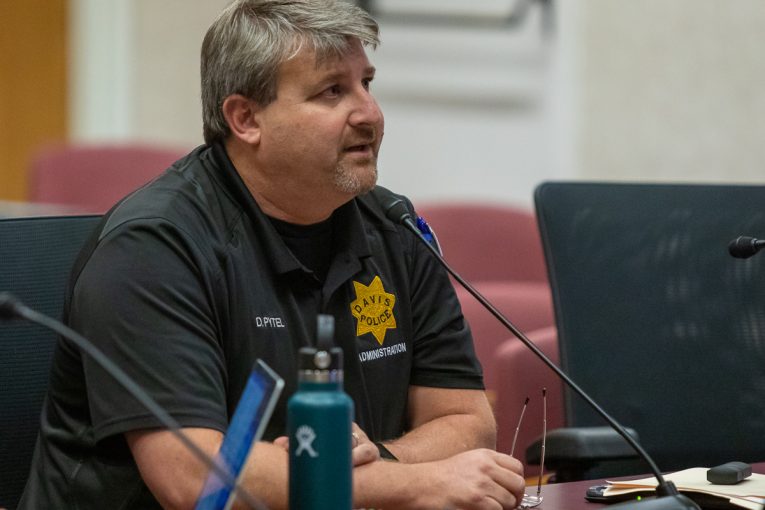

On September 13, 2014, there was a picture of Lt. Tom Waltz in the New York Times. “Police Armored Vehicle is Unwelcome in California College Town” read the article headline.
“This thing has a turret — it’s the kind of thing that is used in Afghanistan and Iraq,” said Dan Wolk, the mayor. “Our community is the kind of community that is not going to take well to having this kind of vehicle. We are not a crime-ridden city.”
The mayor added: “When it comes to help from Washington we, like most communities, have a long wish list. But a tank, or MRAP, or whatever you choose to call it, is not on that list.”
Five years later almost to the day, the council by a 5-0 vote voted to approve a new vehicle that looks less like an armored tank than perhaps an Amazon Prime delivery van. In fact, the chief put up the side-by-side photos as a selling point.
And they have a point – this ARV (Armored Rescue Vehicle) doesn’t have a turret, and it doesn’t look like a piece of military equipment.
The backdrop in 2014 was Ferguson, and in the foreground a few years later would be the Standing Rock protest.
The backdrop in 2019 is Gilroy and El Paso – and who can forget Natalie Corona?
Councilmember Dan Carson said, “If he hadn’t have been a lousy shot, it would have been another mass shooting that you hear about in the headlines, unfortunately every week now.”
He added, “We see headlines in Gilroy, El Paso and Dayton, Ohio. There’s very scary things going on out there.”
Councilmember Lucas Frerichs voted against the MRAP (Mine-Resistant Ambush Protected vehicle). But he said, “This is decidedly not an MRAP.” An MRAP, he said, “was decidedly a military vehicle.” He said, “This is different for me  personally… I also see this as an insurance policy.”
personally… I also see this as an insurance policy.”
Toby, who described himself as a graduate student at UC Davis, made what I thought was the critical point during public comment.
He said, speaking to Chief Pytel, “You have made repeated reference to the new and improvedness of the vehicle in question and yet the only elements that you have pointed out is that it is smaller and more maneuverable. Apparently it doesn’t look like a militarized vehicle.”
He added, “The problem with the militarized vehicle in the first place is not that it actually looks like one, but that it is one.”
He added, “While it is admittedly terrifying to see, in your own community, armored vehicles driving around, what is arguably more terrifying in a much broader sense is to witness the slow encroachment of militarized policing into your community – and to not to know what it leads to next.”
The council did something important in their decision – they assigned the Police Accountability Commission to evaluate the use policy. That is a good start but it is not enough.
Councilmember Frerichs asked Chief Pytel about YONET – the Yolo County Narcotic Enforcement Team. But YONET (thankfully) is no more. They have been replaced by the Task Force. This supposedly administrative task force has been called, by several attorneys I have spoken to, YONET 2.0 for their heavy-handed tactics.
Unfortunately the council missed an important point on Tuesday night. Darren Pytel went through his song and dance about new regulations and use of force policies governing dynamic entries and the like.
In 2014, he told the council and the community that the DPD doesn’t do dynamic entries. But as part of YONET over the last five years, they did plenty of them. Are they going to used armored vehicles to serve high-risk warrants? Of course they will. Will they smash into the wrong homes and throw families and children around? Yes they will. And it is not just YONET that did this.
The problem is this – the council is not going into the courtroom and watching Davis police officers taking the stand and having to defend their work under scrutiny from defense attorneys. If they did, they might have a very different view of this.
Most of the worst of these raids have actually not gone to trial – so we never get to scrutinize police tactics up close, where they no longer have protections of POBR (Peace Officers Bill of Rights) and other state laws to prevent us from being able to look into their policies and practices in real time.
This is about risk assessment. Everyone fears the active shooter situation and I’m not going to downplay those occurrances – they are terrifying and they are real. And they happen a lot more than we’d like.
But these tools are not just being used for those terror situations. They are being used as part of the normal operations of these multi-jurisdictional task forces. Are we supposed to feel better because YONET was busting down doors using West Sacramento’s MRAP rather than our own?
In the time since we returned the MRAP, there have been no situations that went awry that were preventable in Davis if we only had an MRAP. However, on a countywide basis, there have been a number of very problematic and heavy-handed raids that have taken place that have either used existing armored vehicles or in the future could utilize Davis’.
In a lot of ways, Davis’ could be more useful. If you sent in the MRAP, everyone knows that the police are coming in. If you send in the ARV, people might just think they are about to get their Amazon Prime package.
Unfortunately, the council reacted to the fears of active shooter situation without asking for more data and without assessing how these vehicles are being used in this county. That is unfortunate. More unfortunate is that at this point it is going to take a tragic error for us to reconsider this move.
—David M. Greenwald reporting


Interesting choice of the possessive case…
Is it David’s contention that having this type of vehicle causes this to occur? Is there objective evidence which demonstrates this (e.g., before-and-after having this type of vehicle)?
I would say there is a link between equipment and tactics
https://www.nytimes.com/interactive/2017/03/18/us/forced-entry-warrant-drug-raid.html
Yeah, I’m not going to read that at the moment. (I can’t get access to it, regardless.)
Does it specifically address your contention? How about citing the support, rather than general references to an article?
If you’re interested you can start reading on it. I’m in a courtroom on a phone and a link is the best I can do. There is a lot out there to consider.
Not good… hope the bailiff notices… civil disobedience?
“This is about risk assessment. Everyone fears the active shooter situation and I’m not going to downplay those occurrances – they are terrifying and they are real. And they happen a lot more than we’d like.”
It isn’t just about risk assessment, but also risk mitigation. The statistics on Active Shooter incidents nationwide indicate that the vast majority of them are over within minutes of when they start … long before an armored vehicle can be deployed and arrive at the scene. Our experience with the death of Natalie Corona fits that statistical pattern.
So, for me, the decision to purchase this vehicle fits the FDR statement that “The only thing we have to fear is fear itself.”
Why do I say that? Because now that the vehicle has been acquired, the police department will feel an obligation to demonstrate its “value” by using it, even when such a use will raise the intensity of the event it is being used in. Phil Coleman said it best in his comment on Monday.
“The statistics on Active Shooter incidents nationwide indicate that the vast majority of them are over within minutes of when they start … long before an armored vehicle can be deployed and arrive at the scene. ”
Very good point Matt.
The bigger problem is what they are going to use this ARV for – it’s not going to just gather dusk. That’s what worries me. The answer – drug raids in the county.